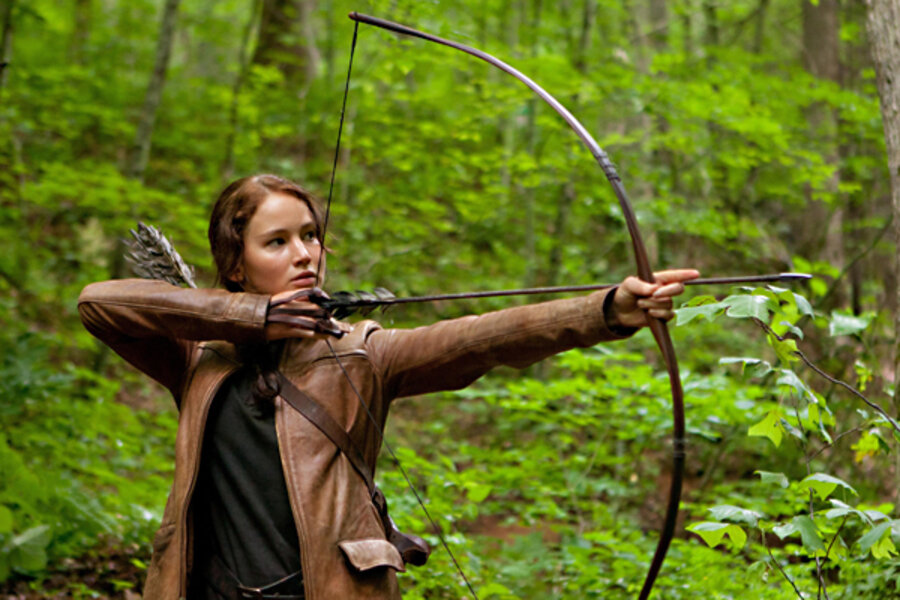How 'The Hunger Games' scored a marketing win
Loading...
“The Hunger Games” movie was expected to be big. But no studio could have dared hope for this.
The first film installment of Suzanne Collins’ bestselling trilogy of young adult novels, which premiered Friday, brought throngs of fans to theaters, to the tune of $155 million at the domestic box office and $59.3 million internationally, garnering a fat $214 million in global profits on its opening weekend. It shattered box office records in the process (before adjusting for inflation).
“The Hunger Games” is the biggest film to open outside of the summer blockbuster season, as well as the biggest nonsequel film debut in history. It was the third-biggest opening weekend of all time, behind last July’s “Harry Potter: The Deathly Hallows Part 2” and 2008’s Batman sequel, “The Dark Knight.”
The film sent stock prices soaring for its parent studio, Lionsgate, and even lent a boost to floundering teen clothing retailer Hot Topic, which sold out some of its supply of Hunger Games merchandise well before the film’s premiere.
"The amount of momentum and speed with which this film swept the country was phenomenal," says Vincent Bruzzese, president of the Worldwide Motion Picture Group, a film industry market research firm based in Los Angeles. "It doesn't hurt that it was a very well received movie, critically. No matter what, from the marketing alone it would have performed, but if you have a good movie on top of that, you get a weekend that just doesn't die."
Lionsgate's marketing for "The Hunger Games" did everything right, according to Mr. Bruzzese. For one, the studio didn't take the formidable built-in film audience from the books for granted, making efforts to ensure that the film could stand alone apart from the books.
"They understood that while they had a lot of incoming equity, it wasn't enough on its own," he says. "They had to create a phenomenon. 'Twilight' did a similar thing, didn't take [the books' audience] for granted. They knew they had to expand the support and let the movie stand on its own so people who didn’t read the book would go see it too."
Furthermore, promotional material for the film shifted the focus away from story elements in the books that would appeal to one group or another, in favor of broad archetypes that resonate across age and gender lines.
"There is a much stronger concentration in the books on the romance. The marketing and the movie shied away from that. They really played up the dystopia, and Katniss as the reluctant but the extraordinary hero, hit archetypes that resonate with everyone." He notes that the "reluctant revolutionary hero" storyline can be found in another huge book-to-movie series, Harry Potter. "Those archetypes know no gender."
What's more, having a female lead is no deterrent in drawing men into the theater, as evidenced by box office hits like "Lara Croft: Tomb Raider," "Resident Evil," and "Salt".
That sets the "Hunger Games" franchise apart from "Twilight," which relied wholly on drawing in the female demographic for its box office success. "You don’t spend a single marketing dollar in that case towards males," Bruzzese says.
He notes that another recent blockbuster, Avatar, employed the same broad-base marketing tactics in reverse: "Avatar" was a science fiction movie, but marketing focused on the Pocahontas-esque love story aspect of the film, to lure in a reluctant female audience.
In addition to a highly effective marketing campaign, the film may have girls to thank for its success. From “Twilight” to “The Help,” it’s been a big year for book-to-film adaptations geared toward a female audience. “The Twilight Saga” Breaking Dawn, Part 1” has grossed $702 million worldwide since its November 2011 release. All together, The "Twilight" franchise has grossed over $2 billion so far, and there’s still one movie to go. The gender breakdown for the audience of “Breaking Dawn: Part 1” was overwhelmingly female, a whopping 80 percent.
“The Help,” the film based on Kathryn Stockett’s novel, has netted more than eight times its $25 million budget.
The big boy-book film release so far this year? “John Carter,” one of the biggest financial flops of all time. Disney released that film, based on the 11-book “Barsoom” series of Edgar Rice Burroughs novels two weeks ago to a chorus of scathing reviews, and expects to lose $200 million on the project. But if male-targeted adaptations aren't faring quite as well in recent years, it may be because the risk factor for studios is generally a lot higher.
"With males, you're looking at science fiction and fantasy, and those books tend to be on a larger production scale," Bruzzese says.
Another reason could be that the film-fertile genre of young Adult fiction is a girl’s world. According to 2003 research by young adult librarians Dawn Cartwright and Patrick Jones (now a teen author), young boys tend to gravitate toward informational texts, nonfiction, magazines, and comic books in their reading. Girls, moreover, tend to have a better comprehension of narrative fiction.
Comic book movies are a proven box office draw, with a hefty male audience. But informational nonfiction? Not so much.
Another factor behind "Hunger Games'" phenomenal debut was its release date in March, a month generally devoid of options for moviegoers.
"They created a tentpole event status in a month not known for blockbusters," Bruzzese says.
As a result, promotions for the movie dominated ad space across platforms, including television, online ads. billboards, and in theaters. And the success of "The Hunger Games" is good news for the entire movie industry, not just Lionsgate. There were no other new film releases last week, but the second-place finisher, the comedy "21 Jump Street," held very well in its second weekend, netting $21 million in the US.







